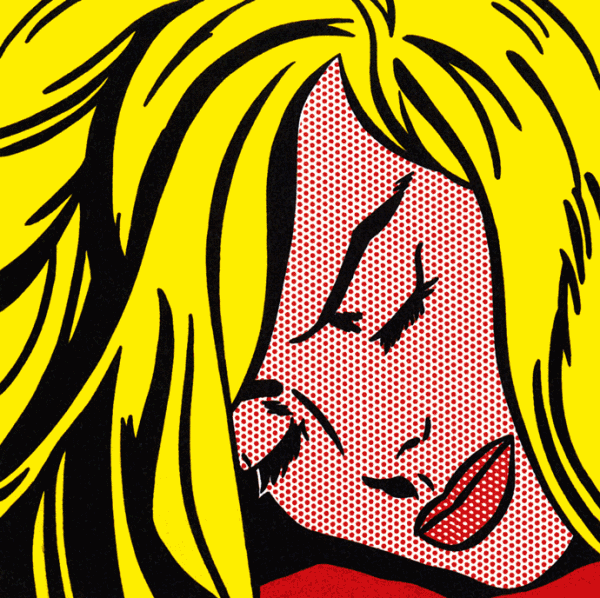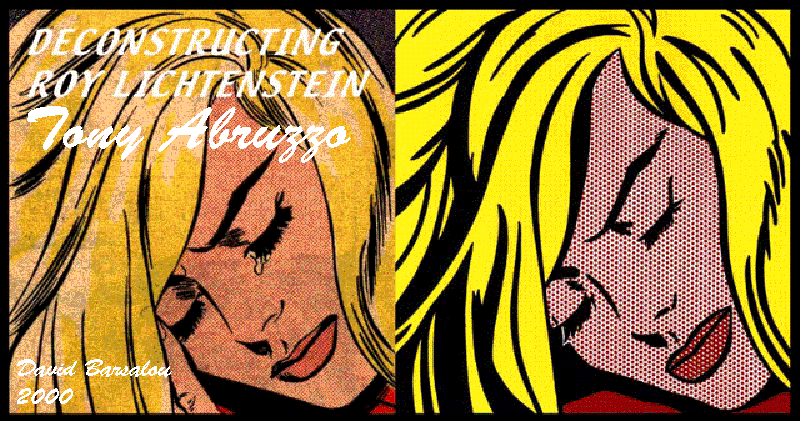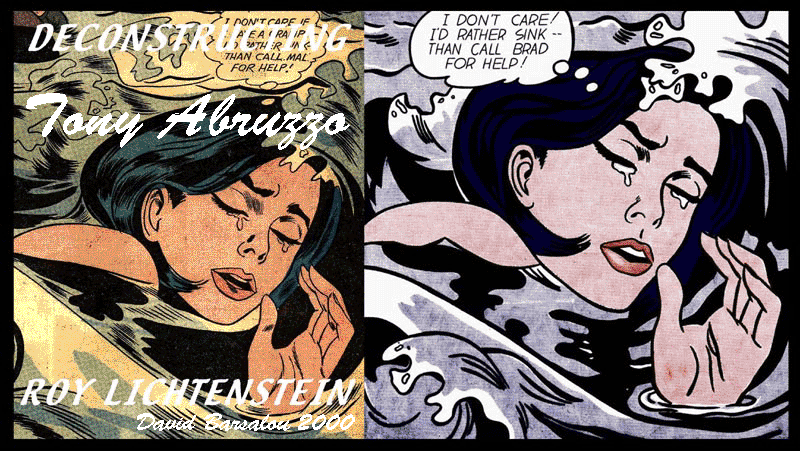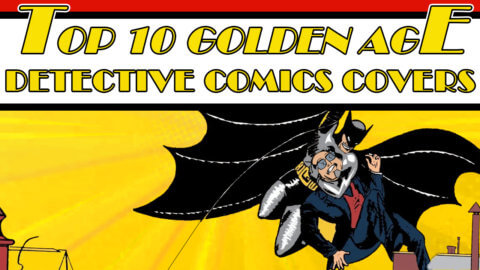 A work by Roy Lichtenstein has sold at auction for nearly $45m, a new record for the US Pop Art icon. Sleeping Girl, from 1964, went for $44.9m (£27.8m) at Sotheby’s New York sale of post-war and contemporary art.
A work by Roy Lichtenstein has sold at auction for nearly $45m, a new record for the US Pop Art icon. Sleeping Girl, from 1964, went for $44.9m (£27.8m) at Sotheby’s New York sale of post-war and contemporary art.
OK I have to be careful not to come off as an uneducated hick that is blind to the merits and subtleties of progressive art!
So Roy Lichtenstein who has works hanging in all the great museums of the world has basically copied panels from comic book artists like John Romita, Russ Heath, Joe Kubert, Tony Abruzzo (who seemed to be one of his favorites) and a whole slew of other familiar names, he’s copied the panels made some subtle changes to them and sent them out into the world as his own.
I’m no art student so I’m not the best guy to be presenting this argument but something does seem out of tilt here. Were the subtle alterations he made to these panels the works of a master correcting the student? Were these subtle changes needed to make these panels true expressions, something just missed by the less worthy original artists, were they homages to the artists in the trenches? I honestly don’t know what they were, though I have read quite a bit on them this morning.
Tate Britain announced this week that it will host a major retrospective of Lichtenstein’s work in spring 2013. Perhaps they should include the original pieces.
What would Tony Abruzzo’s original art page containing the Sleeping Girl frame sell for, a few hundred bucks?
Here’s a great exercise that I’m sure someone has already almost completed. Collect all the original art pages for the panels Lichtenstein has recreated. Done? Good! Now send the matching original art page to Sotheby’s the next time a Lichtenstein piece goes up for sale.
Never mind all that even, just buy some original Kirby pages, it can’t be long before the world finally discovers who the true master really was.
The best site to start exploring this subject is called Deconstructing Roy Lichtenstein, it is posted by an art teacher named David Barsalou.
Below check out the Tony Abruzzo originals on the left and the Roy Lichtenstein reinterpretations to the right.





Walter, I don’t mean to judge and I wont name names… but I am often surprised at the the lack of artistic understanding on this site. But not just on this site… but also amongst comic creators who consider themselves “artists”.
You have to recognize the distinction between “intent” and “execution”. The surface image is only a part of it. High art is a commentary or expression… so the “message” is the art. More so today then ever before…
So while Scott may claim that comics are a medium, I disagree… and the Ettore Sottsass book shelf (which I posted a while back) is more art then anything produced by Marvel. Comics, like Watchmen, can be argued as art, which is one of the reasons it’s gotten so much attention but the bulk of it is no more art then a Campbells tomato soup… Unless someone like Lichtenstein or Warhol uses it to make a statement.
Now… how you interpret the statement is up for grabs. If it all sound hi-brow… that’s because it is… and I don’t agree with the politics of art but in a nut shell. that’s what differentiates Roy Lichtenstein form Tony Abruzzo…
Check this out. I’m no artist… but I can draw better then Edvard Munch… and yet his stuff is fetching $120m:
http://www.cbc.ca/news/arts/story/2012/05/02/scream-munch-auction.html
Take that Action #1!!
Oxford Dictionary defines art as:
“the expression or application of human creative skill and imagination, typically in a visual form such as painting or sculpture, producing works to be appreciated primarily for their beauty or emotional power”
High art is a ridiculous statement in itself and accomplishes nothing but snobs putting themselves on a pedestal.
That’s like saying communication is talking… it’s a very utilitarian definition… and also out dated. Good luck trying to convince the AGO or people like Herb and Dorothy…
http://www.pbs.org/independentlens/herb-and-dorothy/film.html
Simple and concise doesn’t mean utilitarian. Art is for everyone and attains its goal when it stirs something in the viewer. Herb and Dorothy collected pieces from unknown (at the time) artists; mentioning it does nothing for your point.
Charlie, this is a sited devoted to lovers of comic books, what you call “lack of artistic understanding” I will call “attempting to open a debate” on the merits of this kind of art.
So your response is important because it draws out the classic response to anyone that questions the merit of this “high art”, its hows little patience to someone “not understanding” and little tolerance to someone that argues against the artistic merit of the Lichtenstein pieces.
I have no problem with “simple and concise”, but I do take issue with inaccurate or incomplete. My point with Herb and Dorothy is the same as the point I’m making with the AGO, which is, these people don’t subscribe to the definition you provided… not wholely. Feel free to check out their documentary.
Infact, there is a big hyporacy in the world of art. Many of artisans themselves are unable to define what they do. I don’t know if this is because…
• they want to maintain the elitist status quo
• they lack the communication skills
• or they simply don’t know themselves
I’ve spent a lot of time trying to understand art so that I can talk about it in “simple and concise” terms… why? Because, like you, I also believe that art is for everyone.
Walter, I appreciate your well measure and thought out response. I have no problems with peoples likes or dislikes. My main purpose was to try and explain the difference between Lichtenstein and Abruzzo. Perhaps I shouldn’t have made my other point but I do find it interesting that lovers of comic art often compare it to fine art without acknowledging it’s commercial context.
For the record, I’m not favouring one over the other. “High art” is a term I use to describe what the AGO would consider art… but I’m also a fan of people like Bateman who the AGO refuses to recognize. Also, I hope you realize I’m whipping out comments while working here… so I can’t be as refined with my comments as you are.
It’s all context. Mucha did mostly ad work and Rockwell magazine covers; day to day commercial work. Both now highly prized as “fine” art. The definition is quite clear.
So once again Charlie you’re posting just to argue?
Truth be told I did rewrite it a few times!
I’ve been to the Louvre twice but I really feel out of place there. I don’t know what to look for or look at or how to look at it. I’ve often thought that the gallery should hide all the nameplates. Have all the works hanging anonymously. It would be interesting to see the changes in the flow of traffic between pieces.
Scott, let’s not make this post about me. This is a really an interesting topic and worthy of discussion… or debate. It’s true I have my passions and I’ve never hid the fact that I speak plainly and directly. I think my honesty deserves some small recognition here. I also assume we’re all adults… which means we should be able to give and take criticism without reprisal.
If you feel I’m wrong about something… please DO elaborate. But don’t just make blanket statements and expect everyone to swallow it. Back it up with inference, context or deductions.
You once said about a Jeff Smith interview that the public or the media doesn’t “get” comics. You made a statement similar to mine but no one is holding that against you… so it seems unfair for you to superficialize my comments as… “posting just to argue.”
The funny thing is, I’m not even sure what the argument is here. All I did was make the distinction between Lichtenstein and Abruzzo, which many people here are not able to articulate. Was I wrong about this? If so, why doesn’t the CBD crew step up to the plate. I’d love to hear their thoughts on why Lichtenstein is getting paid for ripping off Abruzzo.
Norman Rockwell dismissed his own art as illustration, not fine art. But you’re right, his works are highly prized… As you say, it’s all context and in his case, not only was his work well crafted, but he captured Americana… much like what Bruce Springsteen did with his music. He never intended for there to be any meaning beyond what you see… but, they captured American hearts, none the less. Andrew Wyeth and his father NC Wyeth are other examples. Canada’s Alex Coville’s career really took off after his stint as a war painter. There are reason why certain artists have more cred with the art community than others… and a lot of it is simple PR.
If you’re ever in Stockbridge, do visit the Rockwell Museum. Seeing his originals up close will blow you away and the level of craftsmanship puts todays illustrators to shame!
I think the point you are trying to make is that even illustration can be great. Again, NO ARGUMENT here. In fact, many museums collect works by contemporary illustrators doing corporate work like Brad Holland, Gary Kelly and Philip Burke. Even my old boss, who is only a designer, has stuff in the MoMa. Many commercial products like the Miele vacuum or designer watches like the Ike Pod reside in the vaults of established museums and galleries.
Comic art doesn’t have the same clout yet but I suspect one day it will. Guys like Alan Moore was on their way because Watchmen is more then what you read… it’s a piece of social commentary. The real tragedy about his disagreement with DC is that now, he may not reach that “artistic” stature without a more substantial body of work… but we’ll see. It will depend on how history writes him in.
People like Alex Ross, Adam Hughes are incredible crafts people, possibly more skilled than many famous artists out there. But, as long as they operate in a superficial manner and are technique focused, they will never gain the respect of the art community. Such is the case with wildlife painter Robert Bateman… criticized for painting post card like, picturesque images. Still, he has his audience so his paintings can easily command $100-200k. Comic artists also have their fan base… I see Jim Lee pages selling for $2k to $5k… but does this make him a fine artist. Sadly no. He is a very talented cartoonist… and there is nothing wrong with this.
Hmmm… what were we arguing about again…?
Your comment was obviously considered… and I understand why.
You are also right. Just because a particular artist is famous, it does not mean his work is actually any good. A lot of it is simple marketing, ala Warhol. I trained myself in “art speak” and art understanding because I didn’t like being bullied by pretentious air headed twits. But similar attitudes can be found in “geekdom” which I find humorous.
It comes down to personal taste. But taste should be based on awareness. In other words, there is no right or wrong… there is only understanding.
(WOW… sometimes I’m so deep, I amaze myself!)
What pisses me off about all this money going to art is the wasteful use of wealth by those with more dollars than sense….and that applies to every type of art. These people will spend millions on stuff like this and then give very little to charity (or do so only as a tax break) and complain about paying their fair share of taxes. Personally, I’d like to see the high end of every type of art market come crashing down to a level more in line with reality. This stuff has no real value. This same madness is evident elsewhere; paying a basketball player millions of dollars for doing nothing more than putting a ball through a basket, while someone that contributes something real to a society is paid a fraction of that. The whole market system needs some sanity.
I feel compelled to join this discussion, if I could say what I wanted to without looking like an uneducated moron. I don’t understand art, and don’t pretend to. I know what I like and that’s it. I may prefer “5 dogs playing poker” to the “Mona Lisa” or for that fact, a “Velvet Elvis”. I would rather have a nice Joe Kubert “Hawkman” or “Sgt Rock” original piece than a single red line on a white canvas that is supposedly worth Xmillion dollars just because some “Art Historian” or curator thinks it is important. I don’t think people like Alex Ross operate in a superficial manner at all. Artworks in the Louvre or the AGO, just because they are there doesn’t mean that they are so important. Art is what someone sees as art, whether it’s comics, a father’s day coffee mug from your kid, or a Campbell’s soup can.
All art is, was and forever will be, dependent upon patrons. Simplistically, in the Mediaeval world and during the Renaissance it was the Church. Later royalty, wealthy merchants, the gentry sought out and rewarded their favourites. Later, the Art Establishment dictated form and content and in the search for the new and the novel supported art at the extreme.
Producing art via patronage is not dissmilar from the commercial art ethos. Because comic book or advertising art has a specific creative process does not diminish the final product. And all Lichtenstein did was slavishly copy. Don’ we call that swiping??
Other artists have taken things a step further, by borrowing from Lichtenstein’s style. There’s a great post on Artsy about one such artist (Phillip Lim): https://artsy.net/post/editorial-phillip-lims-lichtenstein-inspired-looks
It’s also worth checking out Artsy’s Lichtenstein page, since they have over 200 images of his work: https://artsy.net/artist/roy-lichtenstein